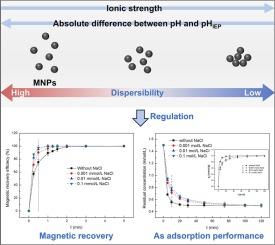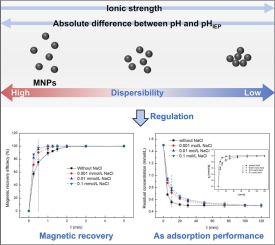磁性氧化铁纳米颗粒去除砷的分散性调控研究
IF 6.9
2区 材料科学
Q2 CHEMISTRY, PHYSICAL
引用次数: 0
摘要
磁性氧化铁纳米颗粒(MNPs)对水中砷污染物的去除已被证明是高效的,但固有的纳米材料团聚对吸附性能和磁性可恢复性的影响尚不清楚。本研究通过实验分析和分子动力学(MD)模拟,全面研究了不同MNPs分散导致As(III)和As(V)去除的差异。在等电点附近和高离子强度下,由于排斥作用的减少,分散性会降低。吸附速率取决于影响吸附位点可达性的团聚程度,以及砷与MNP表面的静电相互作用和络合反应,而平衡吸附容量不受离子强度的影响。此外,通过团聚形成的更大的团簇促进了快速的磁回收,结合的砷物种改变了表面电学性质,进一步影响了回收效率,为提高砷的去除效率提供了见解。本文章由计算机程序翻译,如有差异,请以英文原文为准。


Insight into dispersibility regulation on arsenic removal using magnetic iron oxide nanoparticles
Magnetic iron oxide nanoparticles (MNPs) have been proved highly efficacious in aqueous arsenic contaminants removal while the inherent nanomaterial agglomeration impact on the adsorption performance and magnetic recoverability is still ambiguous. This study comprehensively investigated the varied MNPs dispersion resulting in the differential removal of As(III) and As(V) via experimental analysis and Molecular Dynamics (MD) simulation. It was confirmed the dispersibility would reduce near the isoelectric point and at higher ionic strengths in virtue of reducing repulsive interactions. The adsorption rates depended on the agglomeration degree that influence accessibility to adsorption sites, as well as electrostatic interactions and complexation reactions between arsenic species and the MNP surface, while the equilibrium adsorption capacity remained unchanged by ionic strength. Moreover, larger clusters formed through agglomeration facilitated rapid magnetic recovery, with bonded arsenic species altering surface electric properties and further influencing recovery efficiency, providing insights into improving the arsenic removal efficiency.
求助全文
通过发布文献求助,成功后即可免费获取论文全文。
去求助
来源期刊

Applied Surface Science
工程技术-材料科学:膜
CiteScore
12.50
自引率
7.50%
发文量
3393
审稿时长
67 days
期刊介绍:
Applied Surface Science covers topics contributing to a better understanding of surfaces, interfaces, nanostructures and their applications. The journal is concerned with scientific research on the atomic and molecular level of material properties determined with specific surface analytical techniques and/or computational methods, as well as the processing of such structures.
 求助内容:
求助内容: 应助结果提醒方式:
应助结果提醒方式:


